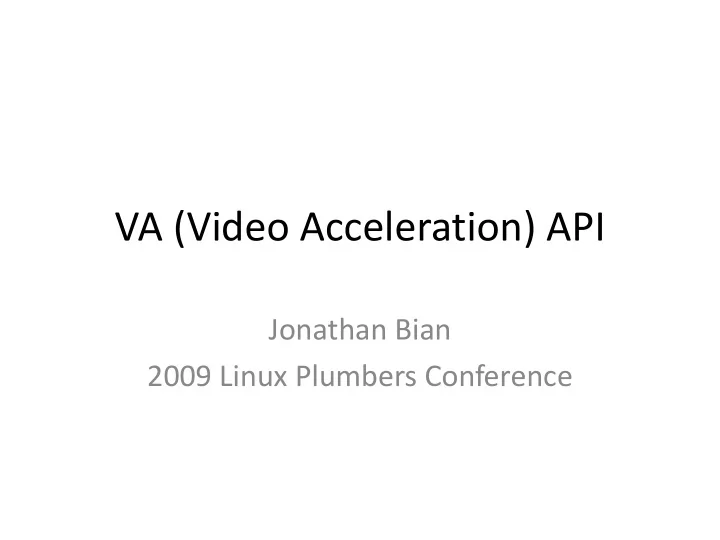

VA (Video Acceleration) API Jonathan Bian 2009 Linux Plumbers Conference
Motivation for creating a new API • Lack of a video decode acceleration API for Unix- like OS that fully exposes fixed function video decode accelerators in modern GPUs – XvMC was designed to accelerate MPEG-2 motion compensation and somewhat difficult to extend to the newer entry-points (e.g. VLD) and formats (e.g. H.264 and VC-1) – OpenMAX DL interface targets optimizing fine-grained primitives on programmable cores and is not suitable for exposing fixed function hardware accelerators
Design goals • The API should accommodate hardware video accelerators from many different IHVs • The decode/encode API should be independent of the windowing system to make codec implementations portable • The interface should be lightweight and extensible, and enable efficient transfer of parameters and coded data between the app and the hardware accelerator • An open API development environment for wider industry and community adoption
Scope of video coding raw raw Pre-Processing Encoding compressed raw raw Post-Processing Decoding VA API supports both decoding and encoding
Slice level decode • A coded picture is divided into slices Slice 0 which are typically made of consecutive macroblocks in raster scan Slice 1 • Slices are self-contained and form the basic units for error recovery • Slice level decode (a.k.a. VLD entry-point) is supported by nearly all current video hardware • App sets up picture and slice parameters, and sends compressed slice data to the HW
API objects • Context : represents a virtual decode or encode pipeline • Configuration : negotiates and configures pipeline profiles, entry-points and attributes • Buffer : stores coding parameters (e.g. picture and slice parameters) and compressed video data • Surface : stores uncompressed video frames (e.g. reference frames) operated on by the hardware accelerator and typically in hardware native formats (opaque to the app) • Image : stores graphical and video pixels in well-defined formats, can be used to retrieve surface data or get client image data into a surface, or compositing video with graphics (e.g. menus and subtitles)
Basic schema for decoding one picture Query profiles, entry- points and attributes Create configuration and surfaces Create context and buffers Send picture params Send slice params and data No End of Picture yes Query Status
Composition and presentation • Composition is done by blending an image with an uncompressed video surface – Supports chroma keying, global alpha, per-pixel alpha • Presentation is performed as a single function call, with a X drawable as the render target – Currently supported operations include de-interlacing, HSBC, scaling, color space conversion, and clipping rects – If the target drawable is a pixmap, then the video frame can be turned into a texture through the texture_from_pixmap extension
Implementation under X Apps DRI libva libva-x11 X server VA HW driver (backend) libdrm Kernel VMM GPU KM
Major milestones • March 2007: First draft of the API spec announced on the x.org mailing list • Sept 2007: libva git repository created on freedesktop.org • Dec 2008: ffmpeg/mplayer support by Gwenole Beauchesne • June 2009: API version 0.30 released with support for encode • July 2009: Intel integrated graphics driver released, libva development mailing list created
Apps and drivers support • Open-source apps: ffmpeg, mplayer, vlc • Commercial codecs: GStreamer (Fluendo), Helix (Real Networks) • Drivers: – Native HW: Intel G45, GMA500; S3 Chrome – Backends: VDPAU, XvBA
Future directions/thoughts • As GPUs get increasingly capable, more advanced post- processing features (e.g. STDC, LACE) become viable - Separate post-processing operations from presentation and enable a modularized post (pre) processing pipeline with pluggable components • Elementary stream entry-points to target consumer electronics and low power platforms • Integration with OpenCL – Ability to download OpenCL kernels into the post (pre) processing pipeline – Extend OpenCL to support fixed function decode and encode
For more information • Browse the VA API project page: – http://www.freedesktop.org/wiki/Software/vaapi – Links to the source repository, drivers and backends, sample code and apps • Join the libva mailing list – http://lists.freedesktop.org/mailman/listinfo/libva – Discuss issues with libva and drivers, as well as enhancements and proposals, submit patches
Recommend
More recommend